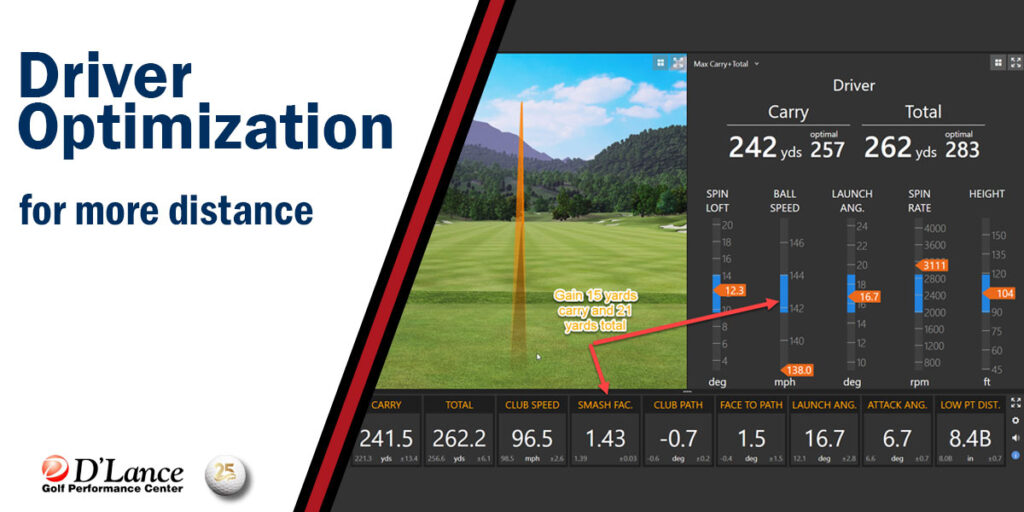
Optimizing driver distance involves several factors including head loft, attack angle, smash factor/ ball speed and forward lean of the shaft. Too often, basic driver fittings focus on launch angle and ignore these important factors. With the help of TrackMan launch monitors, we examine all four key factors in optimizing your driver for accuracy and distance. Plus, with custom club fittings at D’Lance, we can often reduce shot dispersion by as much as 50% and help golfers gain 10 – 20 yards more distance with our Lifetime Driver Fitting and Optimization.
WYNTK About Head Loft
In general, the slower the swing or club speed, the higher the loft of the driver to optimize both carry and roll. Most drivers come in degrees of loft from 8.5 to 13 degrees. Long Drive competitors have drivers that have only 4 to 7.5 degrees of loft. This is because at higher ball speeds, there is considerably more lift created which allows the ball to climb rapidly after impact.
For example, a golfer with driver club head speed of 100 mph and driver launch angle of 10.0 degrees could expect a maximum total distance around 278 yards. Increasing the launch angle to 12.4 degrees could result in a total distance of 293 yards. The resulting improvement is 9 yards more carry and 15 more yards total distance. Read TrackMan’s 10 Fundamentals for Maximizing Distance for more insights.
WYNTK About Attack Angle
There are only two clubs in the bag a golfer should hit up on – a positive attack angle, the putter and the driver. A negative attack angle creates excessive spin and actually reduces distance. The secret: there is no “optimum” attack angle for every golfer. It’s proven that golfers with lower spin, higher launch, higher smash factors, great carry and rollout all have positive attack angles.
For example, increasing attack angle from a descending -2 degrees to a positive +3 degrees can produce 12 yards more carry and 12-15 yards more total distance. However, altering attack angles may affect the driver loft and dynamics of the optimal shaft.
WYNTK About Smash Factor (and Ball Speed)
First off, smash factor is a measurement of efficiency, dividing ball speed by club head speed. An optimal smash factor for a driver is 1.50; tour players average 1.48. The metric is determined by where you hit the ball on the face, how “hot” the face is and how well the shaft delivers energy to the ball at impact. More ball speed equals more distance.
For example, with the right shaft increasing smash factor from 1.46 to 1.49 with a club head speed of 100 mph can result in 23 more yards of carry and 29 more yards of total distance.
WYNTK About Shaft Lean
At the start of a downswing (transition), the driver shaft bends toe-up. For most golfers, right before impact the shaft will recover from its lag and will lean slightly forward. If the shaft butt-, mid- and tip-section are too soft for your swing dynamics, the shaft lean can increase attack angle. Conversely, if the shaft butt-, mid- and/or tip-section are too stiff, attack angles decrease potentially increasing spin.
As noted above, not having the right stiffness throughout the shaft can result in dramatic loss in distance. Optimally, a five-degree improvement in attack angle can result in 12-15 more yards of distance. But if a shaft is too “soft,” that five-degree improvement could actually result in less distance and high spinning shots that are hard to control.
TrackMan Optimal Driver Stats
| Club Speed [mph] |
Attack Angle [deg] |
Ball Speed [mph] |
Vertical Launch [deg] |
Launch Spin [rpm] |
Carry [yds] |
Total [yds] |
|---|---|---|---|---|---|---|
| -5 | 104 | 14.6 | 3720 | 143 | 178 | |
| 75 | 0 | 107 | 16.3 | 3120 | 154 | 191 |
| +5 | 108 | 19.2 | 2720 | 164 | 199 | |
| -5 | 129 | 11.1 | 3690 | 191 | 226 | |
| 90 | 0 | 131 | 13.4 | 3090 | 203 | 240 |
| +5 | 132 | 16.4 | 2630 | 214 | 250 | |
| -5 | 152 | 8.7 | 3680 | 237 | 269 | |
| 105 | 0 | 154 | 11.2 | 3040 | 251 | 285 |
| +5 | 155 | 14.5 | 2560 | 263 | 296 | |
| -5 | 176 | 6.1 | 3430 | 281 | 315 | |
| 120 | 0 | 178 | 9.3 | 2890 | 296 | 330 |
| +5 | 179 | 12.6 | 2340 | 310 | 343 |
Optimizing Driver Distance with a Custom Driver Fitting
During your next driver fitting, make sure you know the actual loft of your driver, club head speed, launch angle and attack angle. Because most drivers are adjustable +/- 1 to 2 degrees now, it’s too miss that a 9-degree driver is actually playing at 10.25-degrees. Assuming you do not change your attack angle, our driver fitting allows us to optimize your effective loft. At D’Lance Golf, we utilize the TrackMan Driver Optimizer to identify areas where we can optimize carry and total distance.
For example, with club speed close to 100 mph, the TrackMan Driver Optimizer can show us that ball speed and smash factor is the major contributor to distance loss. It may also tell us that spin rates are abnormally high, allowing us to focus on the right shaft flex and head loft that brings these into optimal ranges.
